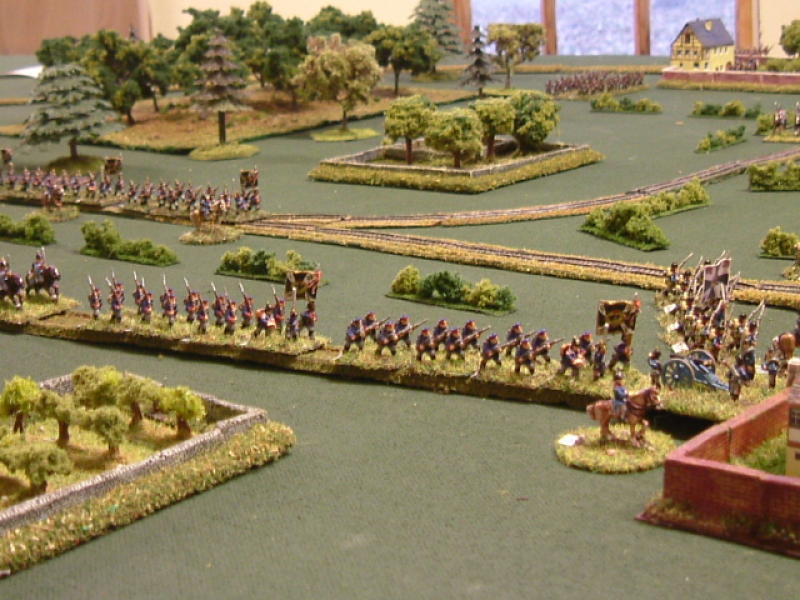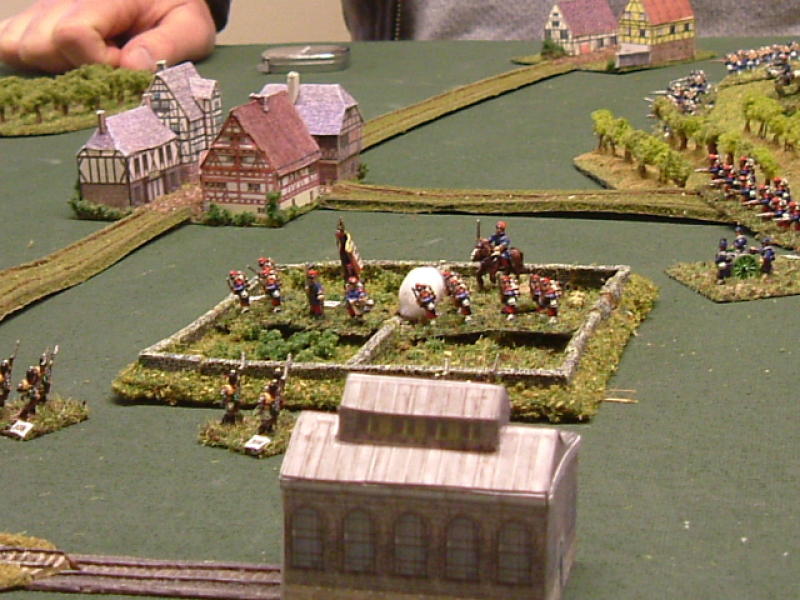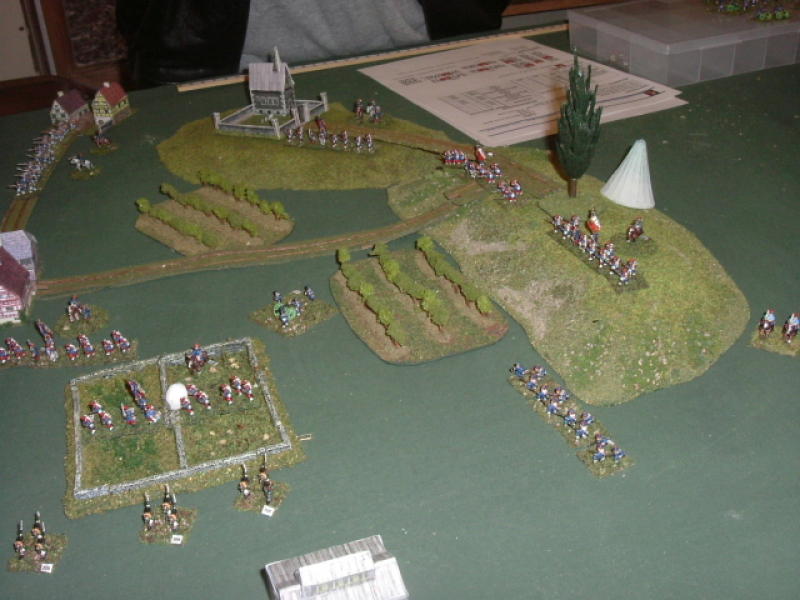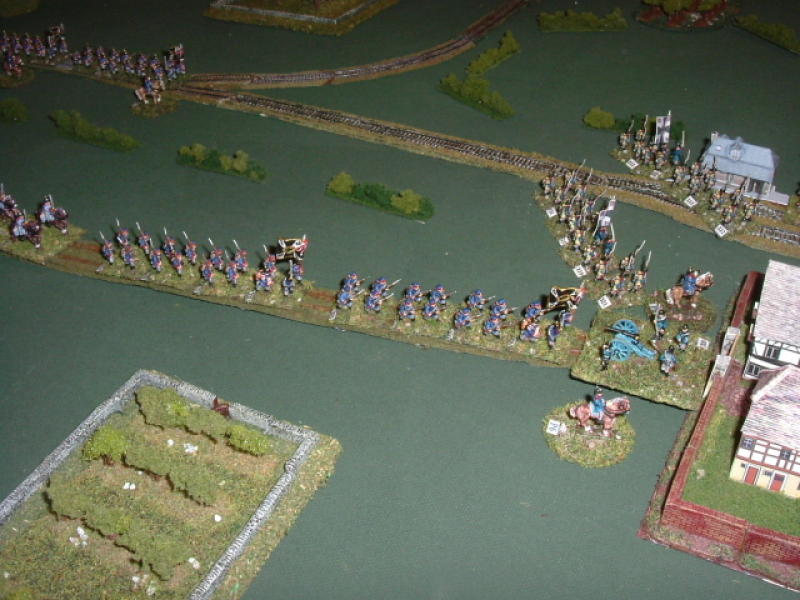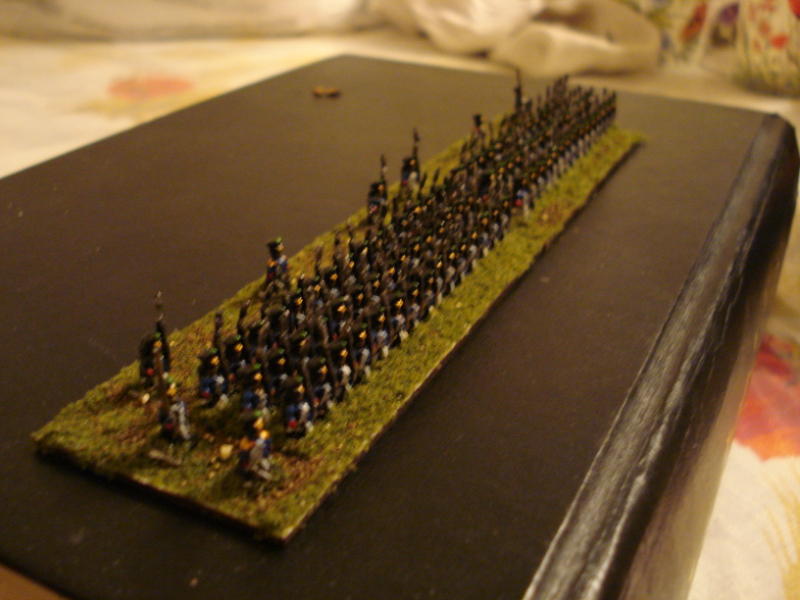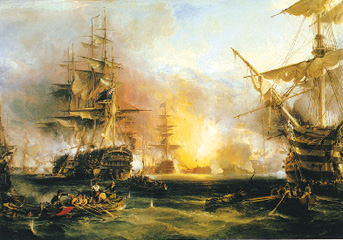 The Bombardment of Algiers.
The Bombardment of Algiers.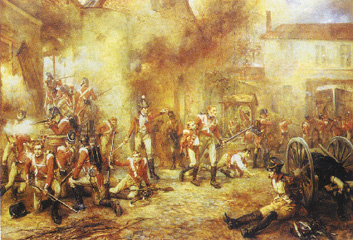 The Defence of Hugomont.
The Defence of Hugomont.Iron Duke is a computer moderated miniatures wargames system for the Napoleonics period, including the American War of Independence and the War of 1812. It is aimed at increasing the historical realism of tabletop miniatures games while reducing the rule complexity, thus allowing the player to concentrate on the tactical and strategic issues.
We are always looking for ideas from players as to what to include or change. It is a "for wargamers by wargamers approach" with the system being sold at minimum cost to encourage computer based gaming as a generally acceptable approach. New versions are being developed on an ongoing basis.
The new Version allows you the ultimate in army, battle and campaign size. There is no limit on the number of units or officers in an army! Battles can have any number of sides and any number of armies on each side! This accomodates even the largest club campaign game. Iron Duke also provides the enhanced Windows usability that allows greater ease of use and faster play without the PC intruding into the players awareness.
There are two main parts to the tactical component of the system, a setup module and a battle module. The first allows you to set up your army and the second allows you to play a battle. In the Setup module units are given a number of characteristics including but not limited to:-
Back to Top
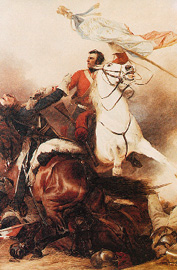 Battle for the Standard.
Battle for the Standard.The Create Army module creates each army separately so that at battle time each army only need selected when you need it. At the start of a battle Iron Duke asks you for the number of sides and the number of armies on each side. This gives you the flexibility to play any army you have against any (or all!) others. You don't have to associates opponent armies at the time when you create them. When in the Create Army module you may save your data at any time. You will also be prompted to save your data once you exit or open another army. Armies may be as large as you like now. Some of the main data elements used to describe units and officers are:-
Name. Up to 40 characters per unit or officer is allowed so that longer names can be accomodated and the historical 'feel' preserved;
Training Level. This ranges over a five point scale from Ill Trained to Highly Trained.
Size of Unit A unit would have the number of troops in it and can be further sub-divided into a number of subunits or elements to allow fire or melee to be split or to represent historical subdivisions such as squadrons within a Battalion. Units may be split to form new units as well as combined.
Weapon types. This includes a larger range of options than before such as Smoothbore Muskets, carbine, rifle, pistol, a variety of smoothbore artillery calibres (eg 6 Pdr, 8 Pdr etc), field howitzers of different calibres and rockets. The effectiveness of rockets has been toned down to match the historical level of inaccuracy.
Skirmishers. Line units can be designated as having one or more subunits of skirmishers and can either deploy the whole unit as skirmishers or keep a proportion back as a parent body. For example, this allows the third line to skirmish. Specialist Light Infantry skirmishers such as British rifle units are also allowed for.
Tactical Style. Even within the same army and nationality, units vary greatly in their battlefield behaviour since they are composed of troops drawn from widely varying backgrounds. This is allowed for by the use of the Tactical Style feature, which gives the unit a different battlefield behaviour pattern. The Tactical Styles accomodated in this period are Regulars, Irregulars, Fierce, Colonial, Colonialised and Woodsmen.
Although most troops are Regulars in this period, some such as Spanish Guerillas could be classed as Irregulars. Militia units in the American War of Independence could be classes as Colonials. Troops such as Iroquoi Indians are probably best classed as Woodsmen. Woodsmen are particularly good as skirmishing from behind cover, but not so keen on close quarters fire fights out in the open. Troops such as Scots Highlanders who were considered more aggressive can be classed as Fierce. The documentation accompanying Iron Duke advises caution with this option however as many players do not consider it historically accurate. The option is provided to give players the freedom to express their historical view of their favourite army.
Morale and Fatigue can be preset before a battle to match historical circumstances such as prebattle forced marches or a prior loss/victory in a campaign.
Flank March arrival times are also preset before battle, although the arrival depends on a number of historical factors such as the commander's ability and the capacity of the troops he is commanding.
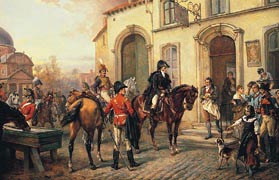 Wellington at Waterloo Village.
Wellington at Waterloo Village.Generals and their orders also receive full attention as the officers personality, efficiency, orders and place in the chain of command is established. Each army has a CNC, Corps level commanders and Divisional level commanders. The interaction between these commanders and the resulting effect on units is controlled by the flow of orders and the officer characteristics. At particluar points in the battle (eg Rallying from Routing) these factors are taken into account by the system in determining the outcome. This allows quite complex evaluations of unit behaviour witjhout any extra burden on the player.
Back to TopThe Battle module has four phases.
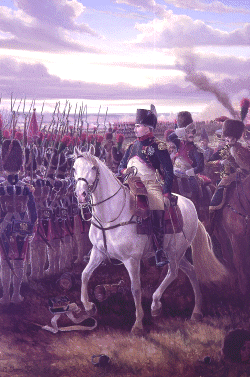 Napoleon at Friedland.
Napoleon at Friedland.1. Deployment. At the start of each round use the Deployment Phase to perform all the actions that are preliminary to combat, such as formation changes, sending Orders, testing for Charges and testing for other events such as a unit's success at scouting or movement through difficult terrain. You should think carefully about your tactics before you issue directions. For example, if a command has been on the defensive (with Hold Orders) and the enemy attack is faltering, you may decide to attack soon. Think ahead and send an Attack order some rounds in advance. Once it arrives and you want to encourage the men to charge, then send their commander to join the key unit BEFORE you test for the charge. Sending him afterwards will be too late. Remember to allow some margin for delays and errors such as a misinterpretation of Orders. This is part of the "fog of battle" built into Iron Duke. You will find that it is quite a challenge to control a battle without modern aids such as direct radio contact. It gives the sensation of how it must have been and you may feel more sympathy for generals of those times after the experience.
A unit that has been involved in a test to charge will not be given a result immediately. This will be given once you move to the next phase (Bombardment). The reason for the delayed notification is that the unit may be involved in more than one charge and these may be against different types of targets. Consequently the total situation needs to be evaluated before the decision can be made on whether the unit charges, stands, runs etc. The total situation is only available once the Deployment phase is concluded.
After players have finished Deploying, choose the next phase, which is Bombardment.
 The Bombardment of Algiers.
The Bombardment of Algiers.
2. Bombardment. By 'Bombardment' we refer to a situation where a battery lobs shells at a distance beyond about 800 paces as quickly as practical (not too quickly in this period due to metal fatigue, dense gunsmoke and other limitations). Bombardment became more frequently used in this period under the influence of Napoleon's tactical reforms, so we have included it so as to help you to create historical battles. A battery may bombard several units during the one turn, each at a different range and with different cover characteristics and ordinance types (eg Common Shell or Shrapnel). The more units that are bombarded the more thinly spread is the bombardment and the less damage done to each unit.
Bombardment is simultaneous and the effects of firing are not applied until the start of the next bound.
 The Rearguard - Crawfurd's Light Infantry.
The Rearguard - Crawfurd's Light Infantry.
3. Firing. To fire, the player chooses the unit from the drop down list, chooses the target and adjust the target conditions (ie range, cover type etc). Then clicks on the Fire button at the bottom of the form. The losses resulting will be displayed immediately. If a unit is firing on more than one target then the player can split the fire according to the number of elements remaining in the unit.
Firing is simultaneous in this period and the effects of firing are not applied until the next bound.
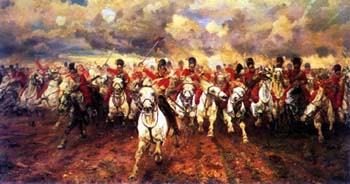 Scotland Forever - Lady Butler.
Scotland Forever - Lady Butler.
4. Melee. At the start of melee, those units that have successfully tested to charge will be tested for charging home on the target in the light of the effect of any firing on them. Some may have taken unacceptable losses and may recoil without contacting their opponent. When fighting more than one target you may split the combat according to the number of elements that are available to fight.
Units that have been involved in a melee will only be given a broad interim outcome at the time of combat. The final outcome will be given once you cycle back to the first phase (Deployment). The reason for the delayed notification is that the unit may be involved in more than one melee and these may be against different types of targets. Consequently the unit may win against one but lose against another. Therefore the total situation is evaluated for you before the decision is made on whether the unit wins, loses, stands, runs etc. Then the position of the unit on the tabletop would be changed according to the outcome shown by Iron Duke.
Grand Tactical module is included at no extra cost.
The Grand Tactical module allows you to play against one or more opponents in the aproach moves that lead to a battle. The players deploy their commands in a landscape with terrain generated by the computer and then move towards a tabletop area marked in the centre of the table. During this Grand Tactical movement, commander ability, encounters with the enemy, difficult terrain and the excessive crowding of friendly commands can all contribute to delays and mishaps. When enough commands have entered the tabletop area the system declares the battle ready to start and exports the armies ready for battle. Commands that have not reached the tabletop area are set to flank march and appear later during the battle (you hope!). A Tactical Map of the battlefield with computer generated terrain and initial starting point for each command is provided for you to print and use as an aid to initial deployment. You now import the armies into the battle module and you are ready to fight the battle!
Solo and Campaign modules are also included at no extra cost.
 Scouts - 10th Hussars.
Scouts - 10th Hussars.
The Solo module allows you to play against the system using a number of scenarios. Responses considered typical of an historical general are provided by the Solo module and are displayed for the gamer to act upon. The amount of activity needed at the screen is reduced as the Solo system handles all formation and order changes within the PC. The player does not need to perform these as well as those needed for his own side. Player intervention in the Solo side's activities is allowed however, so that inappropriate responses can be corrected.
The Campaign module allows map maneauver taking into account terrain and logistics effects on the armies. To increase ease of setup and to enhance the attractiveness of campaign games a number of colour maps with terrain displayed are automatically available for selection in the computer. The computer "sees" the map as a grid, with each sector having certain characteristics such as the arrability of the land, difficulty of the terrain etc.
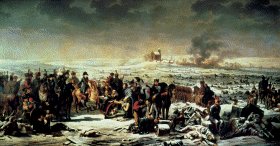 The Battle of Eylau - The Horror of Winter Campaigning.
The Battle of Eylau - The Horror of Winter Campaigning.
The role of Quartermaster has been taken over by the system to reduce the onorous administrative load usually associated with campaigns. Bases can be created and resupply is allowed for. Losses through starvation, disease and straggling are also determined by the system. Sieges can be setup and the associated losses and the outcome are controlled by the system.
 HMS Defence - Battle of the 1st of June.
HMS Defence - Battle of the 1st of June.Naval rules have now been integrated with the existing land based rules. This provides the player with even more options than before. The player can either play the same land based games as before, or play a conventional naval game, or play a combined arms action in which both naval and land forces are present and can fire on each other as well as ram and board.
Each bound the system determines and displays the wind direction and strength, as well as recalculating the maximum turn and speed of each vessel based on a number of factors such as the training level, morale and fatigue of the crew and the state of the ship. A chart is provided to allow the player to calculate the ship's speed based on its angle to the wind. The damage inflicted by enemy fire includes the number of cannon dislodged, flooding and fires caused. The effectiveness of damage control in stopping these problems is reassessed each turn by the system. Under heavy fire a captain may surrender and a ship and be destroyed by fire. Close Actions such as Ramming and Boarding are also supported.
A wide range of naval guns are provided to allow the vessel to be armed historically. These include Carronades, smooth bore artillery and ramming prows. A wide range of ship types is also provided, including 1st Raters through to 6th Raters as well as Galleys, Submersibles, and smaller types such as Cutters and long Boats.
To add realism, several kinds of fortifications have been added to the already extensive range of troop types. These can be armed with artillery and are assumed to have their own garrison. These forts can act as fixed strong points that can bombard, be bombarded, and can resist or be overrun by storming parties. The forts range from hastily fortified positions to heavy stone forts. A cluster of these strong points can be used to represent the aggregation of strong points (bastions) that compose any major fortification.
A battle held at the Hall of Heroes, Campbelltown. HoH kindly set up the tables and invited gamers to the demo game.
 The French and Prusians confront each other. The Prussians are on the defensive on high ground with the French attacking. Cavalry and horse artillery are massed on the far wing.
The French and Prusians confront each other. The Prussians are on the defensive on high ground with the French attacking. Cavalry and horse artillery are massed on the far wing.
 The Lines are closing with the Prussian Lancers charging the French Lancers on the far wing.
The Lines are closing with the Prussian Lancers charging the French Lancers on the far wing.
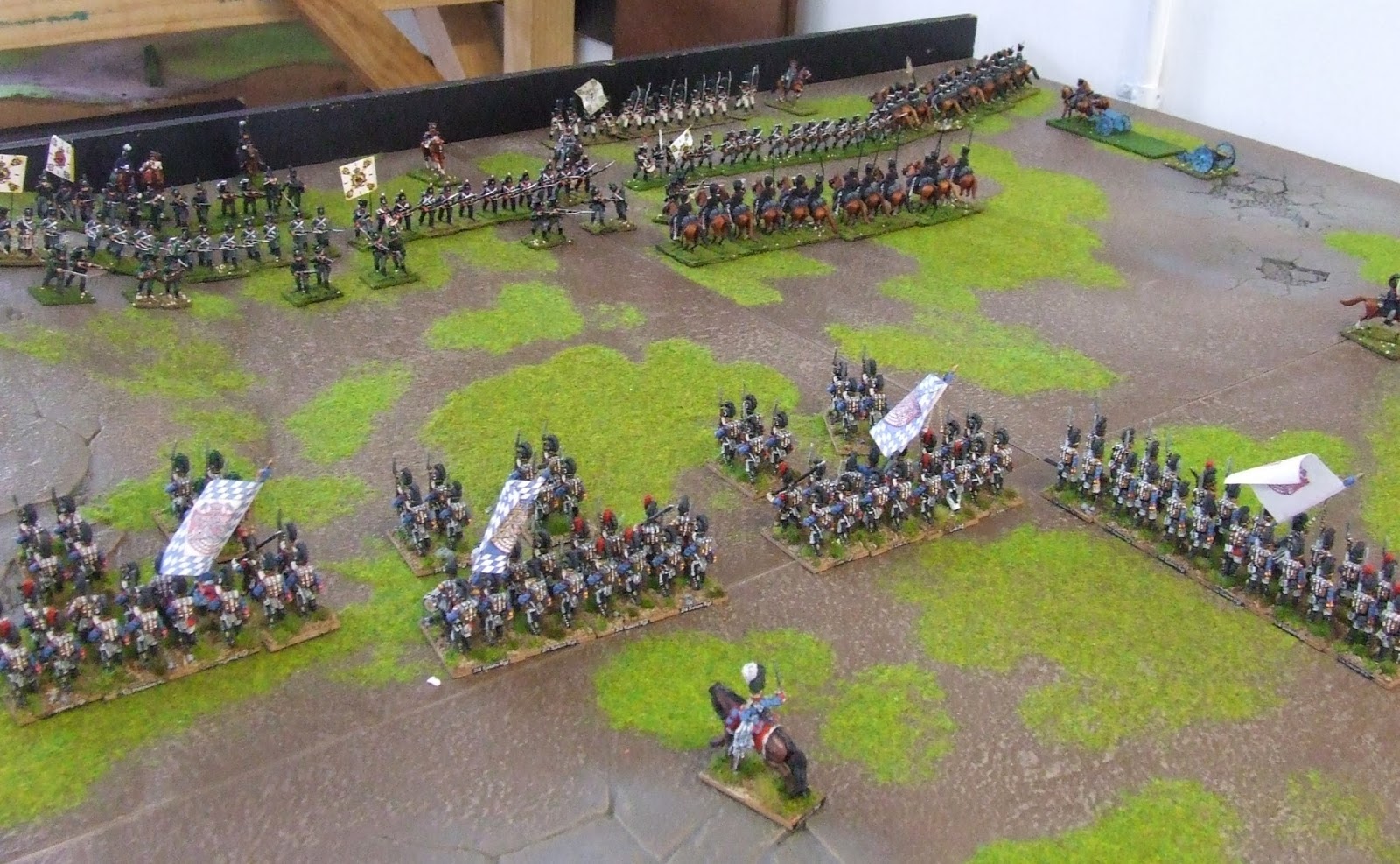 Prussian cavalry and Horse batteries are retiring on the far wing.
Prussian cavalry and Horse batteries are retiring on the far wing.
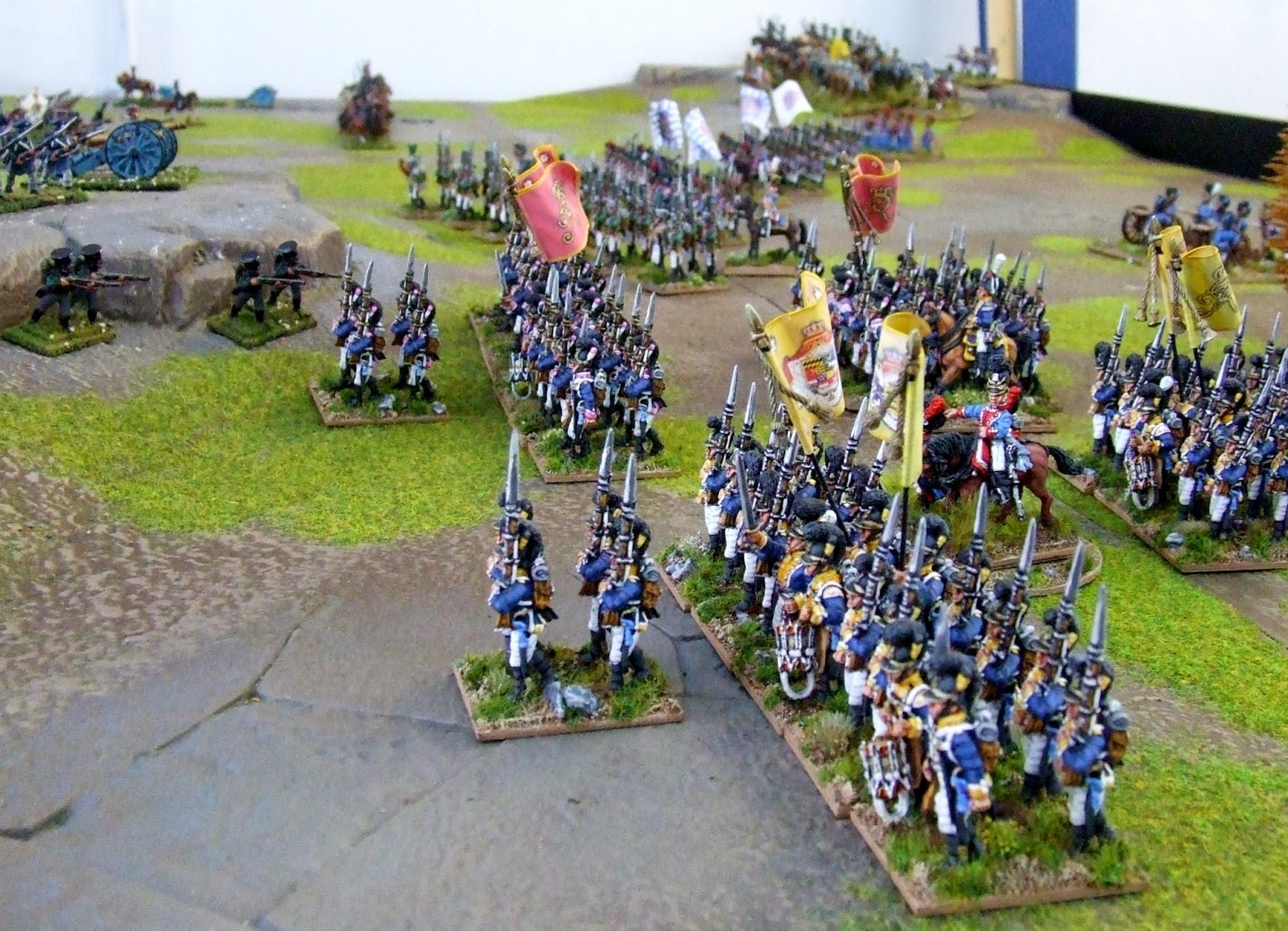 French Line Closing with the Prussians while Jaeger skirmish. Ultimately the Prussians were forced from their high ground and the French were victorious.
French Line Closing with the Prussians while Jaeger skirmish. Ultimately the Prussians were forced from their high ground and the French were victorious.
A set of shots from another demo game. Great scenery.


